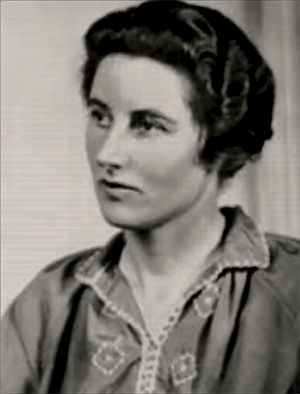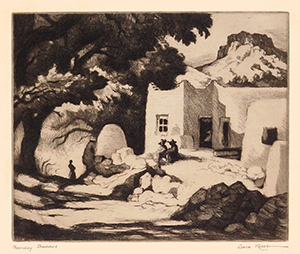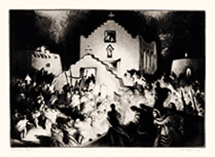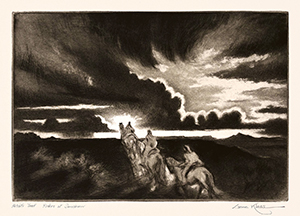
“...a work of art is not complete until it is shared with someone."
“Etching is unique. It is a true abstraction. There is no real black or white in nature. There is no line. But in using those two extremes with all the values in between and a delineation of form, an essence of a subject is depicted..."
—Gene Kloss
“...Gene Kloss captures the very spiritual nature and the culture of northern New Mexico like few artists consistently have... the dynamic skies and light ...and this kind of spiritual other that resides in the landscapes and cultures..."
—Davison Koenig, executive director and curator, Couse-Sharp Historic Site
Gene Kloss, born Alice Geneva Glasier in Oakland, California, was one of the most prominent American printmakers of the 20th century. Renowned for her evocative etchings and paintings of the American Southwest, Kloss captured the spiritual and cultural essence of New Mexico’s landscapes and Native American ceremonies with striking sensitivity and technical mastery.
Kloss developed an early interest in art and studied at the University of California, Berkeley, where she earned her B.A. in 1924. She later studied at the California School of Fine Arts (now San Francisco Art Institute). In 1925, she married poet and composer Phillips Kloss, and soon after, the couple began spending summers in Taos, New Mexico—a region that became central to her artistic identity.
Her first major one-person exhibition, which included almost 100 etchings, oils, watercolors, block prints and monotypes, at the Berkeley League of Fine Arts in March 1926 received popular and critical acclaim and marked the start of a career which included over 70 exhibitions in the Bay Area. From 1933 to 1944 Kloss was the sole etcher employed by the Public Works of Art Project. Her series of nine New Mexico scenes from that period were reproduced and distributed to public schools across the state. She also created watercolors and oil paintings for the WPA. In 1935, she was one of three Taos artists who represented New Mexico at a Paris exhibition called "Three Centuries of Art in the United States".
Drawn to the dramatic light, rugged terrain, and deep cultural heritage of the Southwest, Kloss found endless inspiration in the landscapes, pueblos, and Native American rituals of New Mexico. She eventually settled permanently in Taos in 1960 and was closely associated with the Taos art colony.
Kloss worked primarily in intaglio printmaking, producing more than 600 etchings during her career. Remarkably, Kloss pulled each impression of every edition herself, never relinquishing her artistic power and impeccable standards.
Her work is particularly noted for its rich tonal range, finely observed detail, and emotional depth. She frequently depicted scenes of Pueblo life, especially ceremonial dances, which she witnessed with great respect and often sketched from memory out of deference to their sacred nature.
Kloss’ art was widely exhibited across the United States, and she received numerous honors, including the Eyre Gold Medal, Pennsylvania Academy of Fine Arts 1936; Associate Membership Award, California Society of Etchers 1934; Henry B. Shope Prize, Society of American Etchers 1951; First Prize, Chicago Society of Etchers 1952; Honorable Mention, Society of American Graphic Artists 1953; Purchase Award, Library of Congress 1953; Honorable Mention, Chicago Society of Etchers 1955; Honorable Mention, Philadelphia Sketch Club 1957; Fower Prize 1960 and Purchase Prize 1961, Print Club of Albany; Anonymous Prize, National Academy of Design 1961; Honorable Mention, Museum of New Mexico 1964. Kloss was the first woman admitted to the National Academy of Design in 1950, the greatest honor afforded to artists of her generation.
Kloss maintained memberships in many art organizations including, the Albany Print Club, the Society of American Etchers, the Chicago Society of Etchers, the California Society of Etchers, the Carmel Art Association, the Prairie Print Makers, the New Mexico Art League, the Society of American Graphic Artists, and the Philadelphia Watercolor Club.
Kloss remained artistically active well into her later years leaving behind a remarkable legacy of American printmaking and a body of work that continues to evoke the mystique and majesty of the Southwest. Her works are held in major collections, including the Achenbach Foundation for Graphic Arts, Art Institute of Chicago, Dallas Museum of Fine Arts, Fine Arts Museums of San Francisco, Honolulu Museum of Fine Arts, National Gallery of Art, Metropolitan Museum of Art, Museum of New Mexico, New York Public Library, Pennsylvania Academy of Fine Art, Smithsonian Institution Museums, U.S. Library of Congress, and the West Texas Museum.






